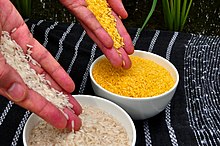
Biofortification is the idea of breeding crops to increase their nutritional value. This can be done either through conventional selective breeding, or through genetic engineering. Biofortification differs from ordinary fortification because it focuses on making plant foods more nutritious as the plants are growing, rather than having nutrients added to the foods when they are being processed. This is an important improvement on ordinary fortification when it comes to providing nutrients for the rural poor, who rarely have access to commercially fortified foods. As such, biofortification is seen as an upcoming strategy for dealing with deficiencies of micronutrients in low and middle-income countries. In the case of iron, the WHO estimated that biofortification could help cure the 2 billion people suffering from iron deficiency-induced anemia.[1]
- ^ Garg, Monika; Sharma, Natasha; Sharma, Saloni; Kapoor, Payal; Kumar, Aman; Chunduri, Venkatesh; Arora, Priya (2018). "Biofortified Crops Generated by Breeding, Agronomy, and Transgenic Approaches Are Improving Lives of Millions of People around the World". Frontiers in Nutrition. 5: 12. doi:10.3389/fnut.2018.00012. PMC 5817065. PMID 29492405.